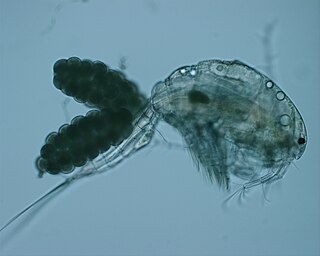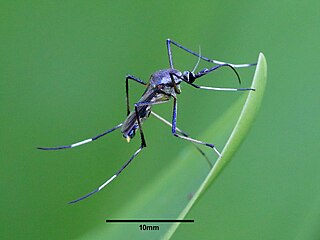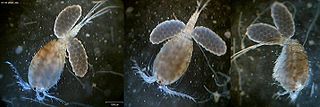
Copepods are a group of small crustaceans found in nearly every freshwater and saltwater habitat. Some species are planktonic, some are benthic, a number of species have parasitic phases, and some continental species may live in limnoterrestrial habitats and other wet terrestrial places, such as swamps, under leaf fall in wet forests, bogs, springs, ephemeral ponds, puddles, damp moss, or water-filled recesses of plants (phytotelmata) such as bromeliads and pitcher plants. Many live underground in marine and freshwater caves, sinkholes, or stream beds. Copepods are sometimes used as biodiversity indicators.

The Cyclopoida are an order of small crustaceans from the subclass Copepoda. Like many other copepods, members of Cyclopoida are small, planktonic animals living both in the sea and in freshwater habitats. They are capable of rapid movement. Their larval development is metamorphic, and the embryos are carried in paired or single sacs attached to first abdominal somite.
Acanthocyclops hypogeus is a species of copepod in the family Cyclopidae. It is endemic to Slovenia.

Afrocyclops pauliani is an extinct species of copepod in the family Cyclopidae. A single specimen was discovered in 1951 in a small freshwater pool near Antananarivo, Madagascar, but the species has not been seen in collections since.

Mesocyclops is a genus of copepod crustaceans in the family Cyclopidae. Because the various species of Mesocyclops are known to prey on mosquito larvae, it is used as a nontoxic and inexpensive form of biological mosquito control.
Metacyclops campestris is a species of copepod in the family Cyclopidae.
Metacyclops postojnae is a species of copepod in the family Cyclopidae.
Muscocyclops bidentatus is a species of copepod in the family Cyclopidae. It is endemic to Brazil. Its natural habitat is swamps.
Muscocyclops is a genus of copepod crustaceans in the family Cyclopidae, comprising three species found only in South America. Two of the species – Muscocyclops bidentatus and Muscocyclops therasiae – are endemic to the Distrito Federal in Brazil, and are listed as conservation dependent on the IUCN Red List. The third species is Muscocyclops operculatus.
Muscocyclops therasiae is a species of crustacean in the family Cyclopidae. It is endemic to Brazil. Its natural habitat is swamps.
Mesocyclops insulensis is a species of copepod in the family Cyclopidae, endemic to Lake Bemapaza, on Nosy Bé island, Madagascar.
Thermocyclops parvus is a species of copepod in the family Cyclopidae. It is endemic to the United States, where it is known only from the Everglades in Florida. Its natural habitat is swamps.

Cyclopidae is a family of copepods containing more than half of the 1,200 species in the order Cyclopoida in over 70 genera.
Afrocyclops gibsoni is a species of copepod in the family Cyclopidae. Three subspecies have been identified:

Cyclops bicuspidatus is a planktonic species of copepod found throughout the world, except Australia, and characteristic of the Great Lakes of North America. It is a deep water species found throughout the year with peak abundance occurring in May or June. Males grow up to 0.8–1.0 millimetre (0.031–0.039 in) long, while females are larger at 0.9–1.6 mm (0.035–0.063 in).

Toxorhynchites speciosus is a species of elephant mosquito in the genus Toxorhynchites, found in Australia.
Mesocyclops aspericornis is a freshwater copepod species in the genus Mesocyclops found in the tropics. It was collected from Sumatra, Singapore and Hawaii.

Macrocyclops is a genus of copepods belonging to the family Cyclopidae. There are currently 13 described species found in fresh water habitats throughout the world:
Mesocyclops longisetus is a species of freshwater copepod in the family Cyclopidae. Two subspecies are accepted, Mesocyclops longisetus curvatus Dussart, 1987, and Mesocyclops longisetus longisetus. It has a neotropical distribution.

Bryocyclops is a genus of freshwater-dwelling cyclopoid copepods. The epithet Bryo- for Bryophyta (Mosses) refers to the fact that the first few species were described from mosses.







